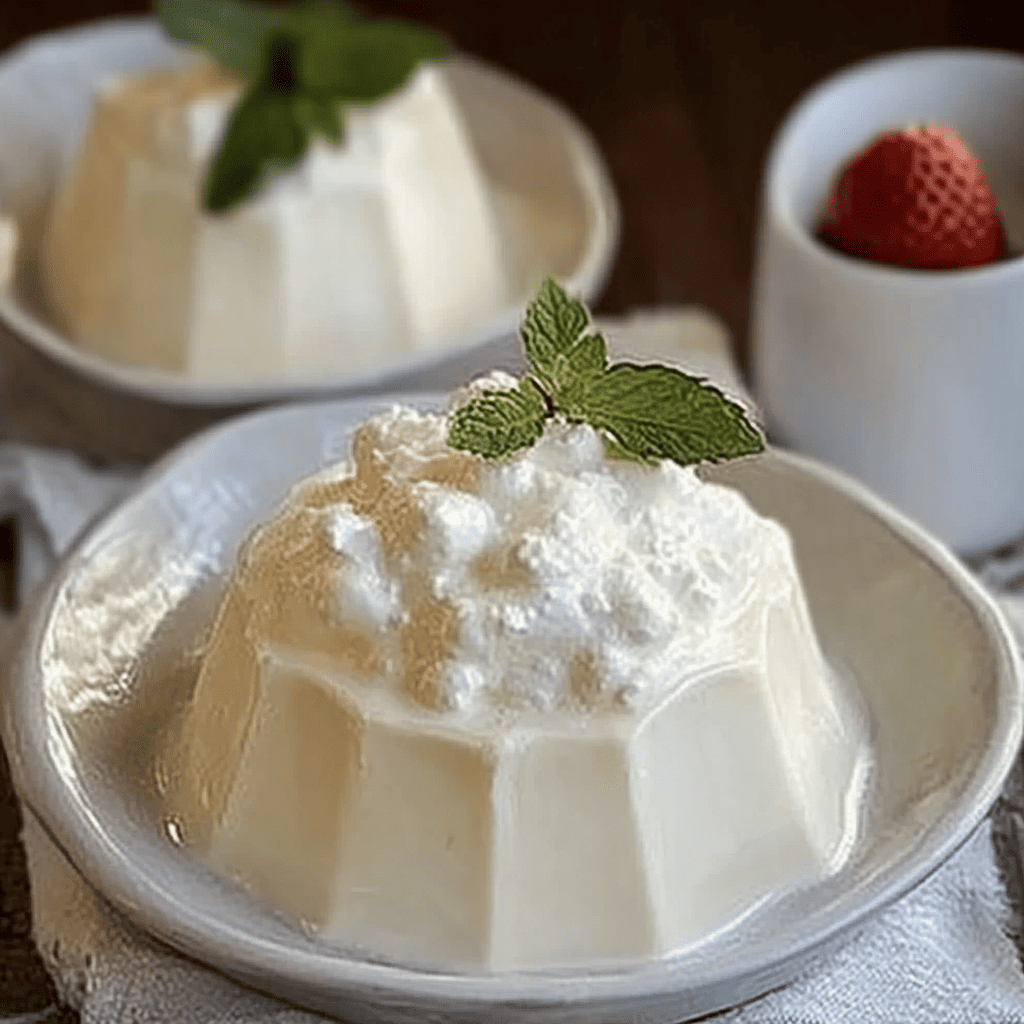Cream Cheese Gelatin: A Soft and Delicious Dessert
Introduction
Cream cheese gelatin is a smooth, creamy, and easy-to-make dessert , perfect for any occasion. Its velvety texture and light cheesy flavor, combined with the sweetness of condensed milk and the fragrance of vanilla, make it an irresistible dessert.
This dessert became popular in Mexico and Latin America , where gelatin is a staple at family gatherings and celebrations. Its versatility allows it to be paired with fresh fruit, sweet sauces, or simply enjoyed on its own.
History and Variations of Cream Cheese Gelatin
Gelatin is a dessert with centuries of history , its origins dating back to 14th-century French and Italian cuisine. However, the modern version with cream cheese is a variation inspired by the famous American cheesecake , combining the best of both worlds: the smoothness of cheese and the lightness of gelatin.
In Latin America, this recipe has evolved with multiple variations:
Cheesecake Jello with Fruit : Strawberries, peaches, or nuts are added for a special touch.
Marbled Jello : Combined with strawberry or chocolate Jello for an appealing visual effect.
Cookie-Based Jello : Similar to cheesecake, but with a gelatinous texture.
Sugar-Free Jello : For those looking for a lighter option, sweeteners can be used instead of condensed milk.
A Detailed History of Cream Cheese Gelatin
Origins of Gelatin
Gelatin is a dessert with a long history. Its origins date back to the ancient Egyptian and Roman civilizations, where collagen was extracted from animal bones to create a thick gel used in cooking. However, gelatin as we know it today began to gain popularity in the 17th century in France and England, when chefs began using it in sweet and savory dishes.
In the 19th century, gelatin was industrialized thanks to Peter Cooper, who patented its production in 1845. Years later, in 1897 , the American Pearle B. Wait created flavored gelatin powder, which made it easier to prepare at home.
The Origin of Cream Cheese
Cream cheese, the key ingredient in this recipe, was created in 1872 by American dairyman William Lawrence , who was looking to reproduce a French cheese called Neufchâtel . His version was softer and creamier, which quickly made it a popular ingredient in baking.
Birth of Cream Cheese Gelatin
The combination of gelatin and cream cheese originated in home cooking in the United States and Mexico in the mid-20th century, when dairy-based desserts became popular. During this time, many families experimented with new recipes using practical and inexpensive ingredients like condensed milk and evaporated milk, giving rise to countless creamy and easy-to-prepare desserts.
In Latin America, especially in Mexico, this dessert became very popular at parties and family gatherings , becoming a classic of homemade baking.
Expansion and Modern Variations
Today, cream cheese gelatin has many variations around the world. Some versions include fruit layers, cheesecake-like cookie bases, or additional flavors like chocolate or coffee. Healthier versions also exist, using alternatives like Greek yogurt or natural sweeteners instead of refined sugar.
This dessert remains a favorite due to its soft texture, sweet flavor and freshness , ideal for any occasion.
Summary of History
Antiquity: Gelatin was used in Egypt and Rome as a thick gel.
17th century: France and England popularized it in sweet recipes.
19th century: Powdered gelatin production became industrialized.
1872: Cream cheese was invented in the U.S.
20th century: Cream cheese gelatin became popular in Latin America.
Today: Many variations of this dessert exist around the world.

Ingredients
- 2 cream cheese bars (226 g each)
- 1 can of evaporated milk
- 1 can of condensed milk
- 1 cup of regular milk
- Vanilla essence to taste
- 28 grams of gelatin (4 sachets)
- ½ cup of cold water
Step-by-Step Preparation
Blend the ingredients
Place the cream cheese, evaporated milk, condensed milk, regular milk, and vanilla in a blender. Blend until smooth and smooth.
Hydrate the gelatin
In a bowl, dissolve 28 grams of gelatin in 1/2 cup of cold water. Let it sit for 8 minutes until thickened.
Melt the gelatin
Microwave the gelatin for 1 minute or until completely liquid.
Add the gelatin
With the blender running, slowly add the melted gelatin to the cream cheese mixture. This will prevent lumps from forming.
Pour into the mold
Pour the mixture into a mold previously greased with a little oil or butter to make it easier to remove from the mold.
Refrigerate
Place the gelatin in the refrigerator and let it set for at least 4 to 5 hours until it reaches the ideal consistency.
Serve and enjoy
Carefully unmold and decorate with strawberries, berries, honey, or caramel to taste. Ready to enjoy!

Questions to Reflect On
How does gelatin affect the texture of gelatin?
What other variations can be made to customize this recipe?
How does the type of milk used affect the final consistency?
Which fruits would pair best with this gelatin?
How can I improve the gelatin’s removal from the mold without damaging it?
What are the differences between this gelatin and a traditional cheesecake?
Questions to Reflect on Cream Cheese Gelatin
- What is the historical origin of gelatin and how has it evolved to the present day?
- Why is cream cheese a key ingredient in this recipe, and what does it contribute to the texture and flavor of the dessert?
- What are the differences between traditional gelatin and cream cheese gelatin in terms of preparation and consistency?
- How has the industrialization of gelatin influenced modern cuisine and the ease of its preparation?
- What other variations of this recipe exist in different countries, and how can the ingredients be customized?
- What is the importance of gelatin in the recipe and how does it affect the final texture of the dessert?
- How can you make a healthier version of cream cheese gelatin without losing its characteristic flavor?
- At what types of events or celebrations is this dessert most common and why is it so popular?
- What other ingredients can be combined with cream cheese gelatin to make it even more delicious?
- How can it be presented in an attractive way to improve its appearance and make it more appealing?
Interesting Facts About Cream Cheese Gelatin
Origin of Cream Cheese
Cream cheese, the main ingredient in this gelatin, was created in 1872 in the United States by the dairyman William Lawrence . Since then, it has been an essential ingredient in desserts and savory dishes.
Nutritional Properties
Cream cheese gelatin is a source of calcium and protein , thanks to dairy. However, due to the condensed milk and cream cheese, it’s also a high-calorie dessert, so it should be consumed in moderation.
Importance of Gelatin
Gelatin is essential for giving gelatin its firmness. It is a protein derived from collagen, making it beneficial for skin, hair, and joints.
Tips to Improve Your Cream Cheese Gelatin
To avoid lumps: Make sure the cream cheese is at room temperature before blending.
For perfect unmolding: Lightly grease the pan with vegetable oil or soak it in hot water for a few seconds before unmolding.
For extra flavor: Add lemon or orange zest for a refreshing citrus kick.
For a lighter version: Use unsweetened condensed milk and reduced-fat cream cheese.
Creative Variations on Cream Cheese Gelatin
Fruit Gelatin: Add strawberries, raspberries, or peaches soaked in syrup before refrigerating.
Two-Tone Gelatin: Make a layer of strawberry gelatin and a layer of cream cheese for a marbled effect.
Cookie-Based Gelatin: Add a base of crushed cookies and butter to simulate a cheesecake.
Chocolate and Cheese Gelatin: Mix cocoa powder into part of the mixture for a chocolatey version.
Ideas for Presenting and Decorating your Gelatin
With fruit: Garnish with fresh strawberries, kiwis, or blackberries.
With sweet sauce: Serve with caramel, honey, or jam.
With whipped cream: Adds an extra touch of smoothness and flavor.
With chocolate chips or shredded coconut: For a crunchy texture.
Curiosities about Gelatin
Dessert with history: It’s believed that the Egyptians used gelatin in ancient times, although its modern version became popular in the 19th century.
Versatile ingredient: Gelatin is not only used in desserts, but also in savory dishes such as aspics and mousses.
Vegetarian alternatives: If you don’t eat gelatin, you can use agar-agar , a natural gelling agent extracted from seaweed.
Texture and flavor
Cream cheese gelatin has a smooth, creamy, and slightly firm texture , thanks to the action of gelatin. Its flavor is sweet and delicate, with a tangy and milky note from the cream cheese and vanilla. It’s a cross between a dairy dessert and traditional gelatin, with a very pleasant mouthfeel.
Consumer context
It’s primarily eaten as a cold dessert , ideal for warm climates, family celebrations, children’s parties, or events like baptisms and birthdays. It’s also an excellent choice for coffee time or as a light, filling snack .
Visual appearance
It has a creamy white or ivory color , shiny and attractive. Its shape depends on the mold used, which can be plain or decorative. It is usually served alone or decorated with fresh fruit, strawberry coulis, caramel, or nut pieces .
Curiosities
- This gelatin is a modern adaptation that fuses the classic Mexican dessert with no-bake cheesecake influences .
- Cream cheese was incorporated into Mexican pastries in the mid-20th century, with the arrival of industrialized products such as Philadelphia® .
- It can be transformed into a marbled jelly by adding a layer of fruit jelly on top.
Estimated nutritional value per serving (1/10 of total approx. 150 g)
- Calories: 280-320 kcal
- Protein: 6-8 g
- Fats: 18-22 g
- Carbohydrates: 20-25 g
- Sugars: 18-22 g
- Calcium: Approx. 15-20% of the recommended daily value
Additional benefits and interesting facts
- Rich in calcium and vitamin D , provided by the milk used.
- Thanks to cream cheese, it contains healthy fats that increase the feeling of satiety.
- Ideal for those who want an elegant dessert that is easy to prepare and without an oven .
- It can be adapted to light versions using reduced-fat and reduced-sugar condensed and evaporated milk.

Conclusion
Cream cheese gelatin is a delicious, easy-to-make, and versatile option, perfect for any occasion. Its creamy texture and balanced flavor make it a refined yet affordable dessert , ideal for surprising family and friends.
Cream cheese gelatin is a dessert that has transcended time thanks to its simplicity, creamy flavor, and smooth texture . Throughout history, gelatin has gone from being a food reserved for the nobility and haute cuisine to becoming an essential element in home baking. The arrival of cream cheese in the 19th century ushered in a new generation of desserts, where the combination of this ingredient with gelatin resulted in an innovative and delicious option.
One of the highlights of this dessert is its versatility . It can be adapted to different tastes and dietary needs, adding fresh fruit, chocolate, coffee, or even replacing sugar with natural sweeteners to make it healthier. Plus, its ease of preparation makes it an ideal choice for family gatherings, parties, and special celebrations.
Another point to consider is its attractive and elegant presentation , since cream cheese gelatin can be served in decorative molds, accompanied by fresh fruit, sweet sauces or even with a cheesecake-type cookie base for an extra touch of texture and flavor.
In conclusion, this dessert remains one of the most beloved in Latin American and international cuisine due to its perfect combination of freshness, sweetness, and creaminess . Its evolution over time demonstrates how simple ingredients can be transformed into unforgettable recipes that endure generation after generation.
Plus, since it’s an adaptable recipe, you can experiment with different ingredients and presentations to create your own unique versions. Don’t hesitate to try it and enjoy its incredible flavor!

